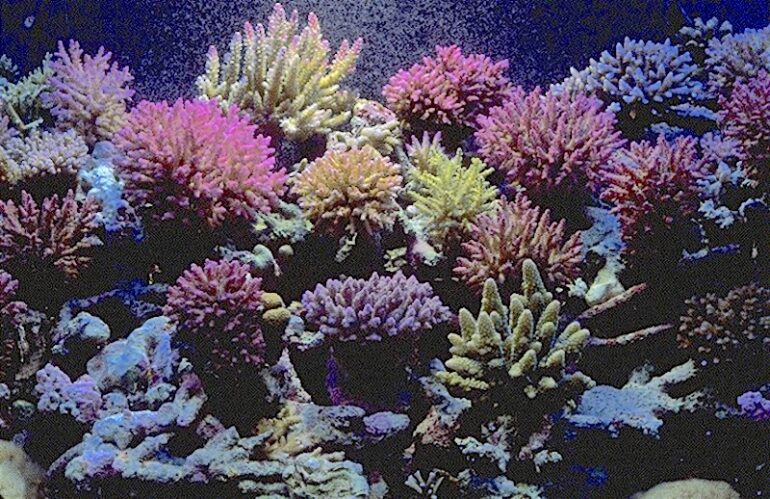Between the inauguration last week and Martin Luther King Day, you could not turn on anything without hearing the phrase “Events that shaped history”. That got me to thinking about the events that shaped the reef aquarium hobby.
While I realize that the majority of people in the hobby today have been in it for less than 10 years, and quite a few less than 5, long before this there were a lot of things that occurred that got us to where we are today. Some of them were seemingly trivial, while others changed things dramatically, but they have all impacted the hobby and gotten us to the level of success we enjoy today.
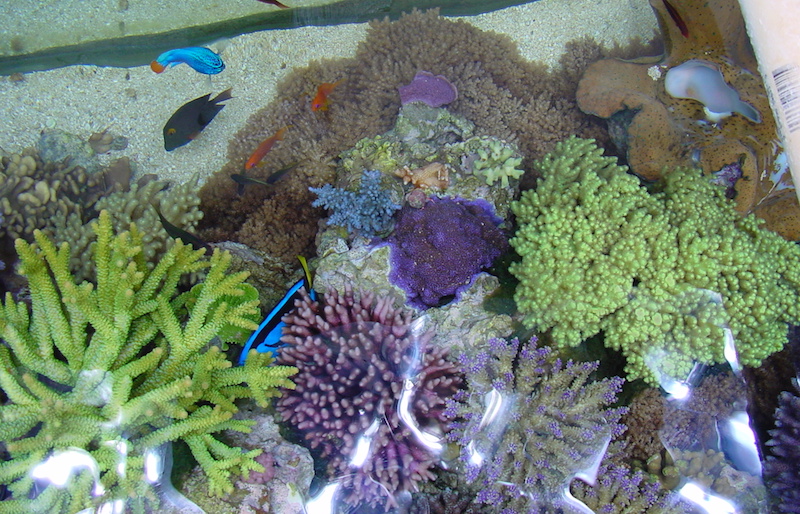
I know that I have forgotten some and that some may disagree on what I think are the seminal events in this hobby, but at least to me these are the events and people that have made the hobby what it is today. Some of them are well-known, while others are largely forgotten, but they all have made contributions that should at the very least be documented. So after reading this if you have others who you think should be acknowledged I invite you to add them and what their contribution has been and how it changed the hobby. Hopefully it changed it for the better.
Most of us who have done this for a while think that “reefkeeping” probably began in Asia in China ore Japan, owing to their proximity to many reefs or Europe where Germany, Italy, Norway and the Netherlands have a long history of keeping fish. And that it probably began in the late 1970’s or early 1980’s. But they would be wrong.
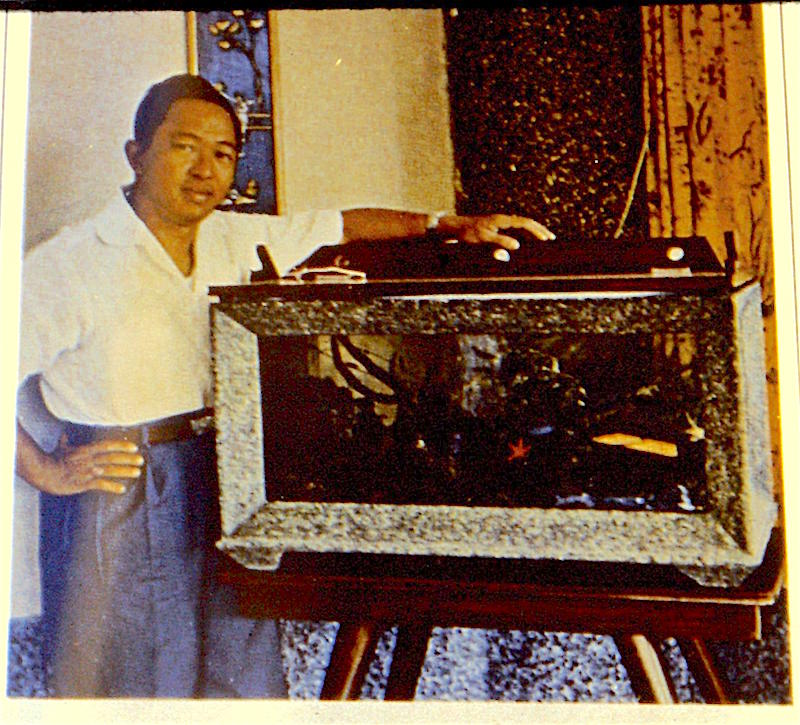
The first article that describes anything close to what we are doing now was actually published in 1961 in Tropical Fish Hobbyist Magazine, written by Lee Chin Eng a man of Chinese descent living in Indonesia. Up until this article was published most saltwater tanks were like those seen here in the 70’s and 80’s, full of dead bleached coral skeletons, coarse sand and a single fluorescent tube for lighting.
His article was the first step away from this, as it stressed the use of “living stones” which sadly he explained very little about as well. Sunlight was the light source and regular water changes with natural seawater and a small air pump to provide water movement. With this he was one of the first individuals to keep live corals and small fish alive for an extended period of time in one of his small tanks.
Interestingly when he wrote this article he included the following statement: “My objective in writing this article is to introduce you to a new system, (no it is not new, it is as old as when God first created the oceans and their contents) to help marine hobbyists all over the world with the greatest of ease and simplicity”.
Unfortunately, unless you lived by a warm sea, and at that time most of the population in those areas did not have the financial capacity to have a tank, this methodology for the most part was “lost” for over 20 years. If we had paid a little more attention the hobby could have been 20 years further ahead than it is now. Regardless of its lack of acceptance, to many Mr Eng remains the founder of reefkeeping.

It would be 10-15 years later that a public reef exhibit of any merit would be seen in the US. The first large reef exhibit that I saw was in the early 1980’s at the Smithsonian Institution where Dr. Walter Adey set up a large display housing Caribbean corals while using the novel concept of an algal turf scrubber to remove nutrients from the water. Having only been snorkeling in areas with limited coral cover I was mesmerized the moment I saw this display.
It was the closest I had ever been to what I considered a “reef tank”. Because of its location and the huge number of visitors that passed through this display undoubtedly prompted many hobbyists to try their hand at reefkeeping. While this technology was in its infancy and as a result did not produce results equivalent to what we see today, it nevertheless changed things and got many of us excited that it might be possible to keep corals alive in a closed system.
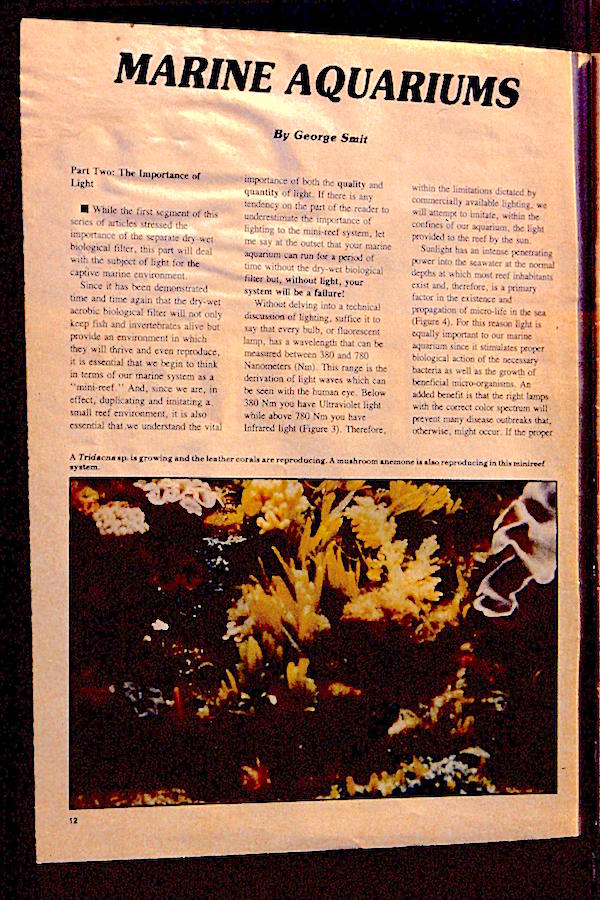
This fire was fully ignited when George Smit introduced the Dutch Minireef through the pages of FAMA magazine soon thereafter. In a long series of articles George introduced many of the concepts we now take for granted in the hobby including live rock, strong lighting, overflows and sumps and the trickle filter.
To me and many others, these articles started us on the path to being able to keep more than just fish alive in our “minireefs”. At first the trickle filter was scoffed at, as no one could believe that you could achieve adequate biological filtration outside the tank itself. Because back then the undergravel filter had proven itself the workhorse for filtration in a saltwater tank for more than 2 decades.
But despite our initial skepticism, many of us designed and built our own trickle filters in the hope of being able to have a Dutch minireef style tank of our own and house corals like those shown in George’s articles. In the short term these trickle filters did indeed prove to be adequate for removing ammonia and nitrite from a tank. However, over time many of us found them to be too efficient in that they were found to be “nitrate factories”.
Consequently when you coupled their high nitrate output with our newly discovered use of intense lighting many of our tanks grew algae at rates far exceeding what we ever saw growing terrestrial plants. As a result, for many of us this is when doing regular water changes on our “reef” tanks began.
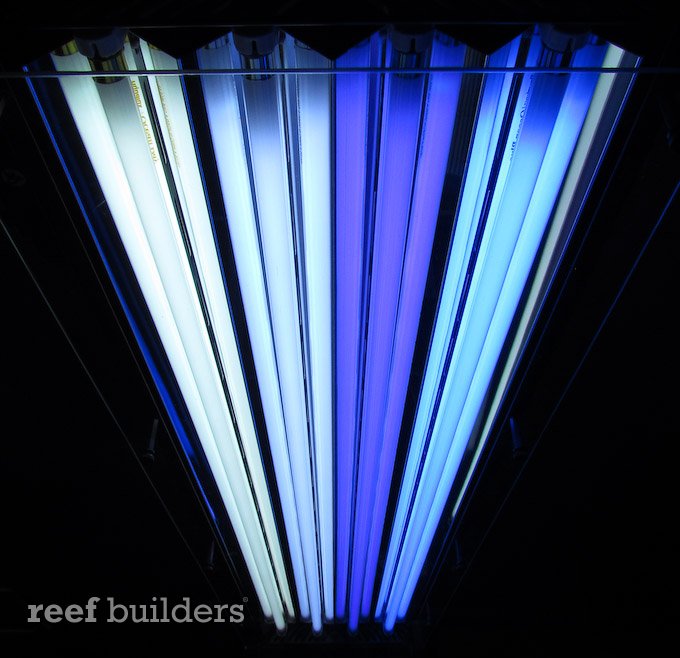
When speaking of lighting on reef tanks two individuals come to mind for changing the lighting of reef tanks. First, John Burleson, an early innovator in the hobby, started using fluorescent actinic lighting on his tanks in addition to the standard warm white or cool white tubes that everyone else was using. John worked for a printer and these ultrablue tubes were used in some printing processes.
While doing research on reefs and looking at pictures it became apparent to John that the water where corals were thriving was blue due to the other wavelengths of light being filtered out the deeper one went in the water. So in order to try and replicate this John was one of the first to try using these blue tubes on his tank. John’s success using these tubes was almost immediate and he quickly let this be known and this started the trend toward us lighting our tanks with bluer light. To this day John had one of the nicest soft coral displays I have ever seen.
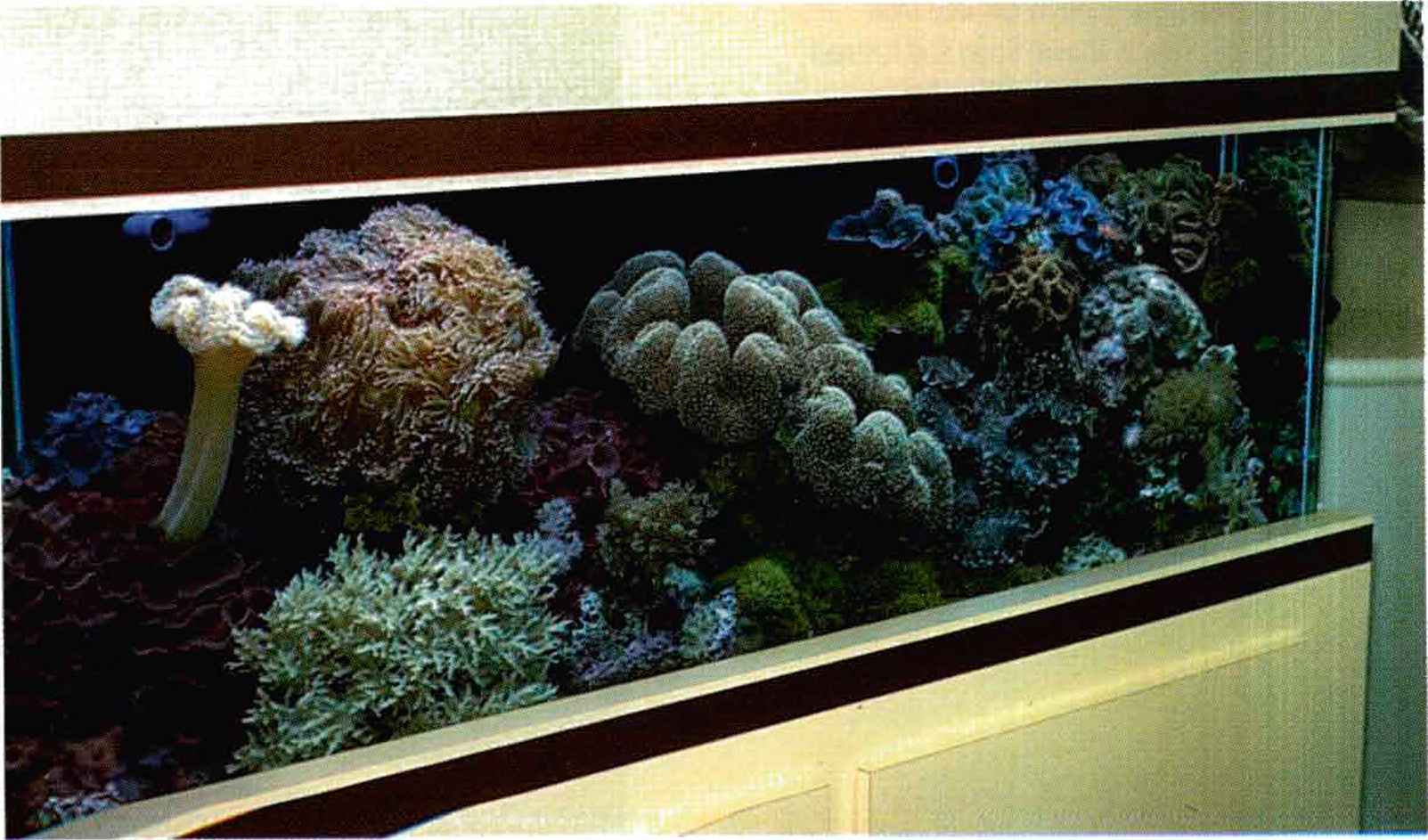
At that time most tanks were being lit with fluorescent or high output or very high output fluorescent tubes. The goal was to have as much light as possible on our tanks as light was the only energy source most of us were providing for our corals. As a result, the goal was to being more and more light to our tanks.
At that time metal halide lamps and reflectors of any kind were not widely available and if they were they had low color temperatures and the fixtures themselves could catch on fire if they were not handled properly. Fortunately to fill that void Wayne Blackburn started building fixtures especially designed to house metal halide lamps and that as far as I know rarely caught fire.
The metal halide boxes that Wayne designed were made of wood and had an aluminum plate above the light that acted as a reflector and a glass plate ran across the bottom protected the bulb from splashes. The boxes used a computer fan for cooling and were vented on one side so that the fan would blow across the bulb.
Even with this cooling though after about a year the inside of the boxes were black from being cooked by the intense heat generated from the light bulb. I must admit they did work and did draw away some of the heat from the metal halide lamps, but if you got behind one of the fans it was like walking behind a bus, the heat was pretty intense.
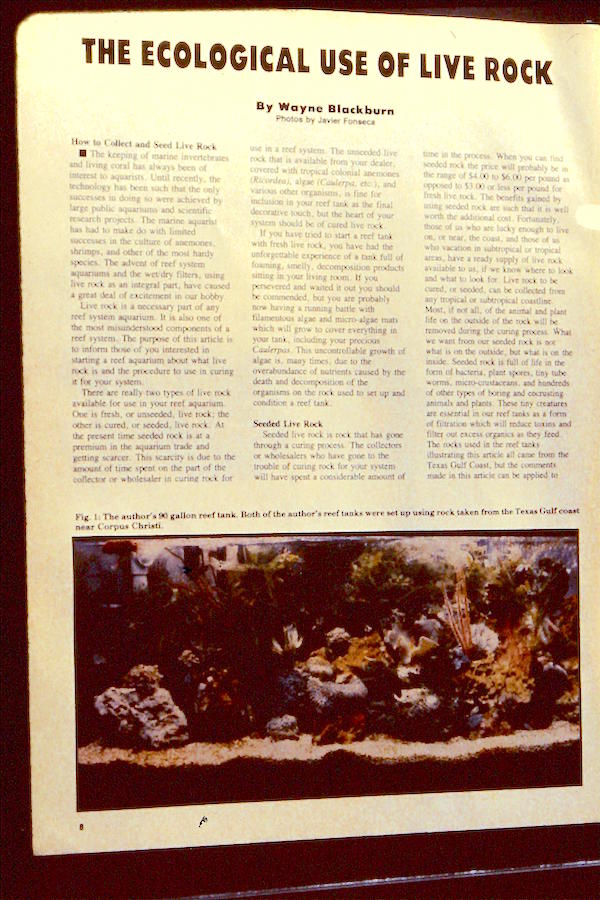
If Wayne had just done this it would have been enough, but he also filled his metal halide boxes with Iwasaki metal halide lamps. These lamps were of higher color temperatures than any other metal halide bulbs bulbs at the time. His promoting these bulbs caused a big stir as for the first time our tanks took on a warmer, ie., less yellow, tone than any metal halides we had used previously. And more importantly the corals had better colors and the tanks looked significantly less glaring. So Wayne’s innovations were a big boost for the hobby.
As the hobby was continuing to grow and more and more of us got the reefing bug, many of the local societies got more and more involved in the “reefing” aspect of keeping saltwater tanks. Many societies would bring in speakers to discuss this new aspect in the saltwater side of the hobby. One of the biggest and most organized of these societies was MAST (Marine Aquarium Society of Toronto).
Its president, Bob James, thought the time was ripe to bring a lot of us together in one spot to discuss what we were doing in the hope that this would further our success. Thus MACNA was born. Looking back, there were approximately 80 attendees and if the first meeting,was held in the US it probably would have had a different name but that is why it is for all of North America. Thanks to Bob, and his wife Debbie, as well as many of the members of MAST, we have this hugely successful marine conference every year.

When this first conference was held our level of success was still minimal. Keeping soft corals, and actually keeping them alive for extended periods of time, what type of media to use in our trickle filters and what combination of lights was the focus during these early years.
However, in Germany things were advancing rapidly. In Berlin, a group of hobbyists, led by Dietrich Stuber, were having much great success and were even keeping sps corals alive including the holy grail of corals: Acropora. These hobbyists were using large protein skimmers instead of trickle filters, and this new mysterious compound called kalkwasser to try and have the water in their tanks be chemically close to natural seawater in composition. As a result of their success, this successful methodology got to be known as the Berlin method.
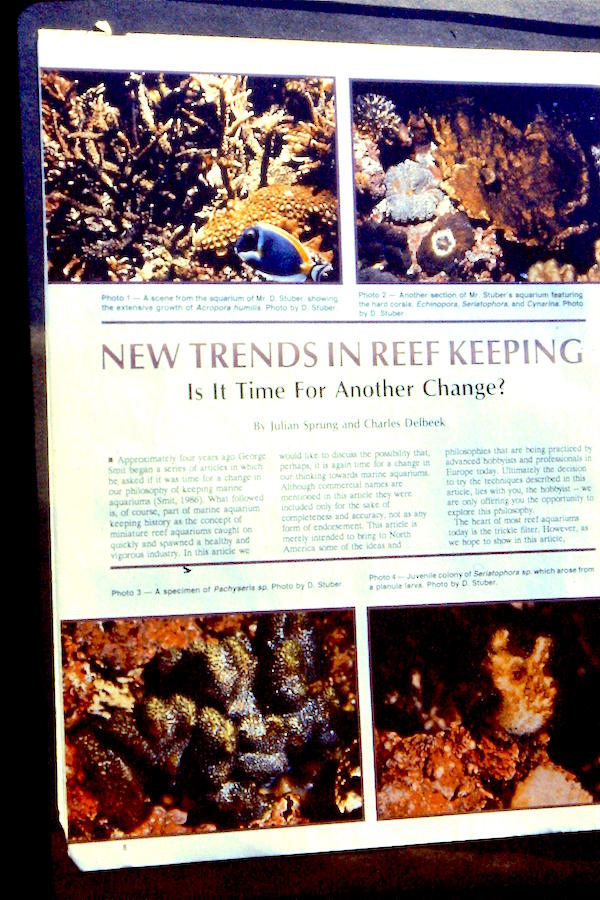
This methodology would have been kept from us for years had it not been for two individuals writing about it and showing us how much closer to reefs these Berlin tanks were compared to ours. Charles Delbeek and Julian Sprung, in an article in Tropical Fish Hobbyist magazine asked the simple question: Is it Time for a Change.
In this article they outlined the Berlin method and showed how successful this method was even for keeping the then impossible to keep sps corals. As much information as the article provided, the pictures that were included showed these corals thriving, including the first shot of the now famous Stuber Acropora.

This article was just the start however, as soon in a series of articles in Aquarium Fish magazine, Alf Nilsen outlined in fine detail each critical aspect of this system. Reading back over these articles now was fascinating in that what we now pretty much take for granted in terms of our understanding of water chemistry and what is necessary for success Alf reveled for the first time.
For anyone who has the opportunity, I suggest you look over all of these articles just to get an idea of how far we have come and thank these gentlemen for providing much of the blueprint for our current success.
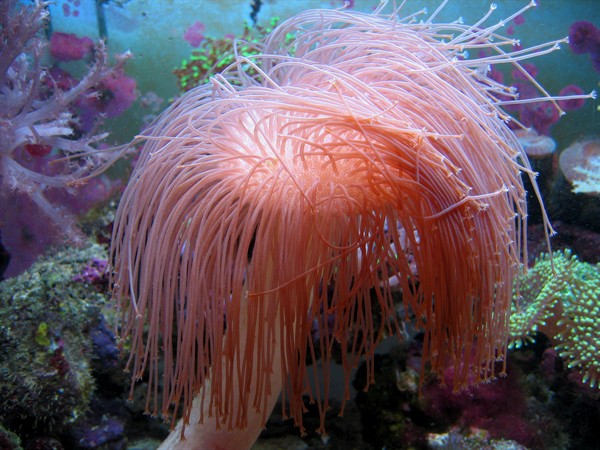
It should be noted that initially most of us that switched over to the Berlin system did indeed achieve almost immediate success, but for most of us this was on already relatively successful soft coral tanks. So it was hard to really judge how successful this system really was because as we now know these corals are actually usually pretty hardy.
The reason we could only do this on soft coral tanks initially was that sps corals simply were not widely available. At best some stray sps would come in from time to time or we would see a frag of an sps coral attached to the base of a soft coral and try to grow it out, but there simply were not sps corals to be had on any kind of consistent basis. All of this changed however around 1992 when Lech of Aquatic Depot and his manager Millie started bringing in weekly shipments of sps corals from Fiji.
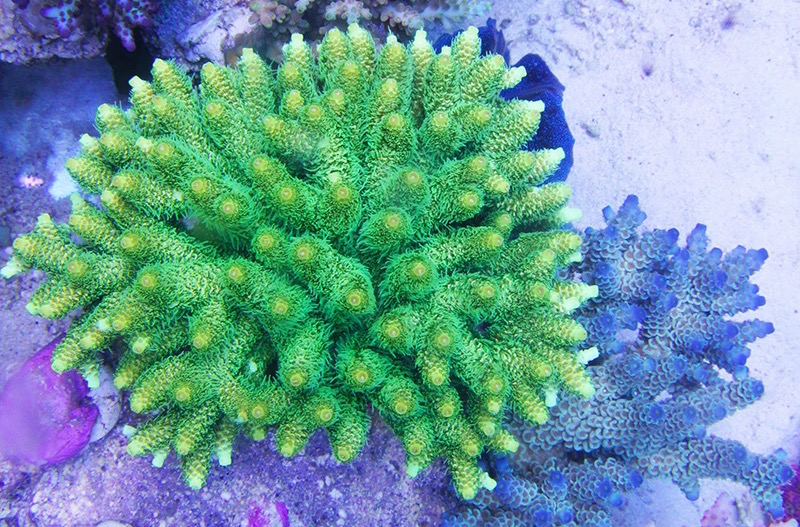
This wholesale facility in Los Angeles changed the whole dynamic of the hobby when they started bringing in healthy colonies of sps of every color and type imaginable. During those early years the shipments would come in on Wednesdays or Saturdays and once we knew the shipments were coming I would fly out from Pittsburgh every month or so and anxiously await the arrival of the boxes.
Fortunately, Millie was hobbyist friendly so she would let me along with my friends who owned stores open the boxes as soon as they arrived. For all of us it was the closest thing to adult Christmas morning in that each box always had something new and unexpected that we had never seen before. Because of their bringing in these sps corals the hobby again expanded dramatically.

One of the individuals who I used to open these boxes with was Steve Tyree, who lived nearby to their facility at the time. Steve was as excited as anyone when we opened the boxes and since he was a regular there he developed an eye for which corals had the best colors and which had the best potential for good coloration in his tanks.
However, like many of us had seen a lot of these corals had wonderful coloration when when first got them, but over time they would fade or brown out. Not satisfied with this, Steve began working with other lights and started using Radium 20K metal halides. As a result, the corals in Steve’s tanks had and kept their colors far more than they did in most of our tanks.

So using higher temperature lights, bluer, changed how many of us kept our corals in terms of lighting. In addition to this as noted above, Steve knew which corals possessed the best colors, but unfortunately these corals often only came in rarely so only one or a few individuals would be able to have them. But knowing that lots of us wanted them he started propagating them so that more of us could have them.
Also in order to keep track of what was what, Steve started naming them. Now while this has now developed into a major marketing tool in the hobby, back then it was more or less done so we all knew what was what and also to keep track of the lineage and give credit to whoever first found the coral.
While Steve was propagating corals on a small scale two other individuals at this time began propagating corals on a large scale. Dick Perrin of Tropicorium and Leroy and Sallee Jo Headlee of GARF, both set up facilities to grow and propagate the corals we all wanted. Dick used a greenhouse on the side of his home as the base for his propagation. When I first walked into his facility with Tom Frakes and saw the literally thousands of corals he was propagating I felt it was the closest I had ever been to a reef on dry land.
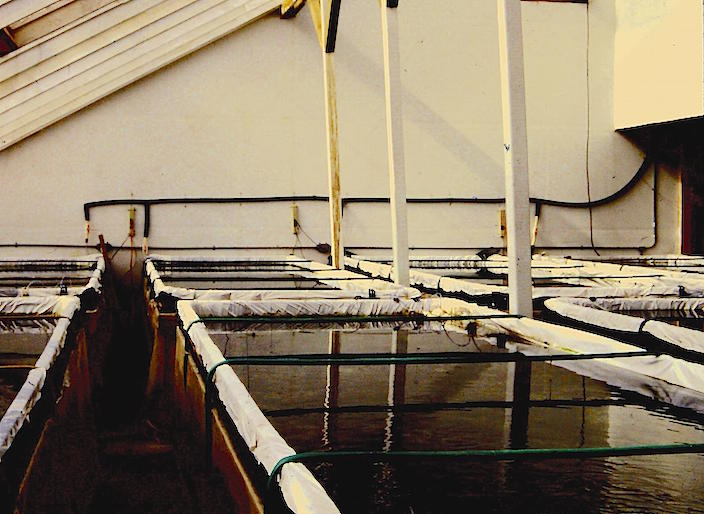
There were corals of every type as well as clams and even fish. The huge custom build vats were rather rudimentary in construction but the level of success that Dick was having was evident in every system. While smaller in scale, the propagation of corals that Leroy and Sallee Jo were doing at GARF was equally as impressive.
This facility was run on geothermal power so not only was it impressive from the propagation work they were doing, but it was also impressive as it was almost a completely green facility. Leroy and Sallee Jo were also unique in that they wanted to share their success and as a result they had classes to try and teach others how to set up commercial propagation facilities. Much of what these early propagators did and taught is still in use by some of the people propagating corals today.
The last major change that I will discuss in the hobby is the result of work that Patrick Ormiston of PFO lighting brought to the hobby when he brought out the Solaris lamp, which was the first commercially available LED light in the US. I still recall being at MACNA and walking in the front door and seeing him and Joy Meadows, now of ReefBrite, standing at the front with this lamp over one tank and a 250-watt metal halide over the other with a PAR meter on each tank showing that they were producing approximately the same amount to light.

Having run metal halides on my tanks for over 20 years, I thought it nothing short of revolutionary. And it was, but unfortunately there were patent issues that drove Patrick form the business and so the Solaris never evolved into the LED lamps we see today. However, because Patrick provided a look into where the future of lighting was going to go in the hobby he and his first LED lamp need to be included in events and people who changed the hobby.
As I said I could not include every event and everyone who changed the hobby. While writing this I also thought of Leng Sy and not only his Miracle Mud, but also how he brought having a refugium to our attention and how it might enhance our tanks. And Chris Turnier and how his site Reefer Madness changed the hobby by selling corals online for the first time on a large scale and making corals available virtually anywhere.
And also Bruce Carlson who helped form the bond between public aquariums and hobbyists. And as I said there are many more people and events that I have probably forgotten so if you have an event or someone you feel dramatically changed the hobby please write about it in your comments as no one who has contributed to this hobby should be forgotten.


